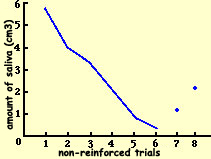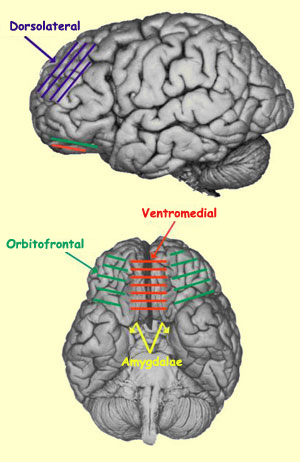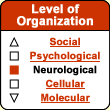|
|




In animal studies, researchers
extinguish conditioned fears by ceasing to apply the aversive
stimulus, thus teaching the animals that they no longer have
anything to fear.
Suppose, for example, that researchers
have conditioned a fear in a rat by letting it hear a certain
sound, then applying an electrical shock to its paws through
the floor of its metal cage. The rat soon learns to avoid
the shock by jumping through a door into an adjacent compartment
of the cage where the floor is not electrified. If the researchers
then close the door and start playing the sound without applying
the shock, the rat soon learns that the sound is no longer
associated with the shock and stops trying to get through
the door. The rat's avoidance behaviour is then said to have
been extinguished.
This same process provides the basis for the cognitive-behavioural
therapies that are used to treat anxiety disorders.
|
|
|
| BRAIN ABNORMALITIES
ASSOCIATED WITH ANXIETY DISORDERS |
|
Conditioned fear (follow the Experiment
module link to the left) is regarded as the primary mechanism
underlying many anxiety disorders, such as phobias and post-traumatic
stress disorder. A conditioned fear exists when a neutral stimulus
is strongly associated with an aversive one in a person's mind.
After a while, the neutral stimulus alone suffices to produce
anxiety—for example, when the low rumble of thunder suddenly
plunges a former soldier back into all the horrors of the battlefield.
| Anxiety disorders can be treated successfully
with behavioural therapies (see sidebar) that extinguish the
underlying conditioned fears. This process of extinction involves
gradually weakening the conditioned fear until the conditioned
stimulus (in the preceding example, the sound of thunder) is
no longer associated with the aversive stimulus (the horrors
of battle). In other words, over time, the patient learns how
to overcome the association that he or she had formed between
a neutral stimulus and a fear. In addition to the passage of
time, a change in context can also facilitate the extinction
of a conditioned fear. |
|
 |
Extinction is thus an adaptive phenomenon:
if the actual threatening situation is not recurring, no purpose
is served by continuing to experience fear simply because its context
has recurred. Researchers have therefore proposed that certain
anxiety disorders may be due to a malfunction in the mechanism
by which conditioned fears are extinguished.
Also, a number of studies have shown that deconditioning through
extinction does not involve actually erasing the conditioning,
but rather learning something new in addition to it. Extinction
is thus different from forgetting.
The original fear is still there; it is simply masked and is no
longer expressed.
 |
|
Other experimental data
support the idea that fear conditioning and fear extinction
are carried out by different parts of the brain. The
role of the amygdala in fear conditioning is well established.
The role of the prefrontal cortex in fear extinction is less
well established, but the ventromedial portion of this cortex
definitely plays a role in this process, just
as it does in depression. This makes sense, because the
prefrontal cortex has long been known to play a role in inhibiting
inappropriate behavioural responses.
In experimental studies, when lesions were made in an animal's
ventromedial prefrontal cortex, they did not prevent it from
learning new conditioned fears. But when the researchers then
attempted to extinguish a conditioned fear (for example, by
subjecting the animal to a sound without the accompanying electric
shock that it had previously been taught to expect), the process
of extinction took much longer. |
The precise role of the ventromedial prefrontal
cortex remains ambiguous, however, because it does not seem to
be needed to achieve the extinction itself, but only to recall
the newly learned information some time after extinction has been
achieved. These observations would therefore suggest that this
structure's role is more to consolidate the extinction or to recall
the context in which the extinction took place.
The ventromedial prefrontal
cortex receives connections from the sensory areas and the
amygdala and returns axons to the amygdala. It would therefore
seem well placed to exercise cortical controls over the amygdala—for
example, by
generating the process of extinction. If these cortical
controls are impaired, however, the extinction of a conditioned
fear becomes very difficult. And indeed, one of the most
classic symptoms of damage to the frontal
lobes in human beings is the inability to cease
a behaviour when it becomes inappropriate.
The prefrontal cortex also seems to participate, like the hippocampus,
in the negative feedback loop that lowers the level of stress
hormones when it becomes too high. And like the hippocampus,
the prefrontal cortex might also become impaired by persistently
high levels of glucocorticoids, thus interfering with this
control mechanism and releasing the natural brake on the amygdala.
Consequently, any new emotional stimulus would be more strongly
encoded and would become very resistant to extinction.
 |
|
|






